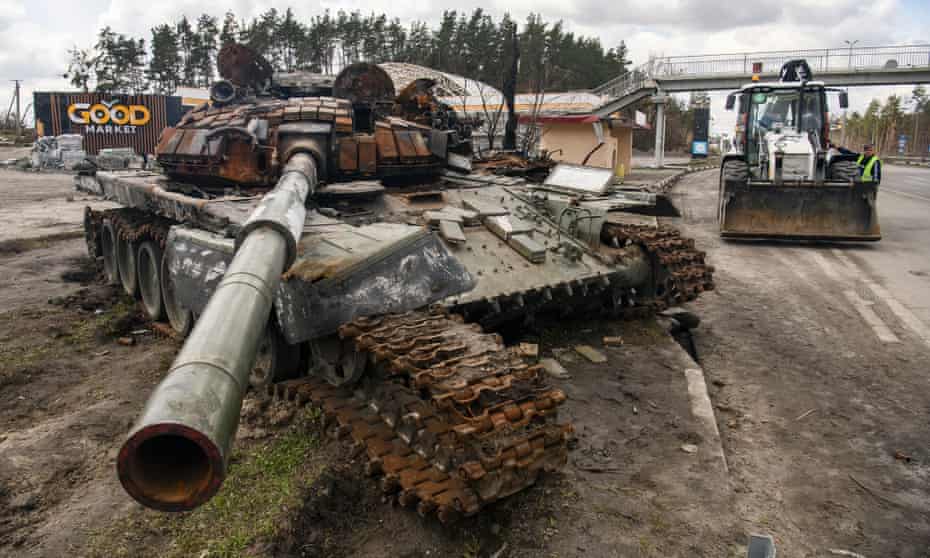Analysis: west faces dilemma as Moscow and Kyiv prepare for trial of strength in Donbas

How does the war end in Ukraine? At the moment it is far from obvious – which is why both sides are girding for a trial of strength in Donbas after Russia was forced to abandon its attempt to capture Kyiv.
Russia’s current military activity appears to back up what are in effect reduced war aims: targeting the entire Donetsk and Luhansk oblasts claimed by the so-called separatist republics, both recognised by Vladimir Putin just before the war broke out.
An eight-mile convoy, spotted on Friday by satellite imagery, 50 miles east of Kharkiv, is likely to be heading for Izyum, once again bringing to mind one of the early images of the war. Russian forces have been, for several days already, trying to push from Izyum south to Slavyansk, but not so far making much progress.
Tracey German, a professor in the defence studies department at King’s College London, said Russia may have already increased the number of battalions in eastern Ukraine “from 30 to 40 in recent days” – and a single front “may be more achievable and could provide Putin with something that can be depicted as a victory”.
The belief in the west is that Russia can “double or perhaps even treble” its forces in the Donbas, potentially a decisive shift in Moscow’s favour. Already Russia has stepped up preliminary operations, bombing the quickest supply lines for the forces dug in in the area.
The airport in Dnipro, the largest city behind the defensive lines, was destroyed by a Russian attack over the weekend, the local governor acknowledged, while Friday’s cruel missile strike on the railway station in Kramatorsk, an attack that killed more than 50 people, was also intended to disrupt Ukrainian manoeuvrability.
Moscow’s problem is whether its already battered forces can carry out the task: 37-38 of its battalions are “combat non-effective” after being harried around Kyiv, Chernihiv and Sumy, according to an estimate from western intelligence on Monday. That leaves Moscow with a total fighting force about 90 battalions strong. At full strength each battalion should have about 800 troops.
Elsewhere in the east, Russian forces are getting edging closer to seizing control of Mariupol, cutting the city into two on Sunday, according to the Institute of the Study of War, at a high cost to the attackers and a far more fearful cost to its citizens.
“Tens of thousands are dead,” Ukraine’s president, Volodymyr Zelenskiy, estimated on Monday, in a speech to the South Korean parliament, although the grim struggle for control of the port city has further demonstrated to Moscow it cannot capture any more of Ukraine’s population centres without high casualties to its own forces.
For Ukraine, the problem of the current phase is acute, if no longer existential. Kyiv has shown it can mount effective counterattacks against overextended Russian mechanised forces with western anti-tank weapons – but its forces are also depleted and have not been able to push the Russians back far, if at all, in the south and east.
Its focus in the first instance will be trying to stem the Russian advance, to avoid its forces being enveloped in Donbas, and instead grind Russia to a something like a stalemate as both sides become increasingly exhausted after what would be more than two months of fighting.
That would nevertheless leave Ukraine largely cut off from the sea, and Russia with a land bridge from Donetsk to Crimea. Ukraine may not be demilitarised as Putin demanded, but its economy is nevertheless devastated, shrunk by an estimated 45% this year, according to the World Bank.
President Zelenskiy, however, has repeatedly demanded more and better weapons from the west as he hopes to turn stalemate into victory. So far what’s been offered – in public at least – is not enough to turn the military balance, such as a dozen T-72 tanks from the Czech Republic, 10 Switchblade 600 drones from the US or 120 armoured vehicles from the UK.
The question for the west, for whom Ukraine is effectively fighting a proxy war, is whether to step up supplies so that Kyiv can turn the tide on land, force Russian forces out of Kherson near the mouth of Dnieper River in the south, and drive the invaders back elsewhere in the Donbas.
The refusal to supply Russian-designed fighter jets from eastern-bloc Nato members suggests the US, in particular, is nervous not just about provoking an unpredictable Kremlin but also about altering the balance too far. A tipping point could be whether Poland is allowed to supply about 100 Russian T-72 tanks it has in its arsenal.
It may be a difficult balance to strike. Do Ukraine’s western allies want to give Putin a bloody nose, or simply try to provide enough arms in the hope of forcing a return to the positions before fighting broke out on 24 February? If Ukraine were in a stronger military position, Kyiv might seek to reclaim the Donbas territories occupied since 2014 – where Moscow’s defence may be fiercer.

Leave A Comment